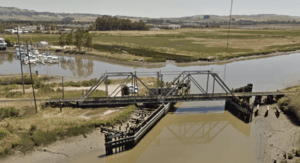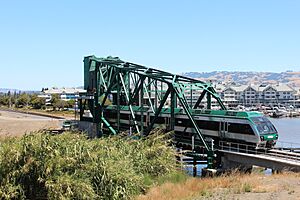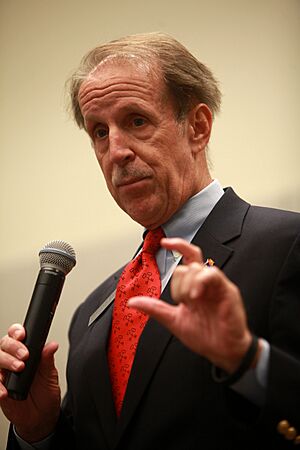Haystack Landing facts for kids
Haystack Landing is a special historical place in Sonoma County, California. It used to be a busy spot where people and goods traveled by boat on the Petaluma River and San Francisco Bay. Today, you can still see an old dock for steamboats and a railroad bridge there. A company called Dutra Materials owns the land and plans to build a new asphalt factory. Haystack Landing was even talked about during a political campaign in 1996, which caused some discussion.
Contents
A Look Back at Haystack Landing
In the mid-1850s, a man named Rudesill built a dock at Haystack Landing. This dock was for loading passengers and cargo onto steamboats. Soon after, the Petaluma and Haystack Railroad was created. This railroad connected directly to the dock. Train service began on August 1, 1864. It was only the third railroad ever built in California!
This connection was very important for trade. Goods could travel from the northern areas down the Petaluma River. This river then connected to San Pablo Bay and San Francisco Bay. Some of the most common items traded were eggs, chicks, and grain.
To help trade grow, the government looked at the Petaluma River in 1879. They found that one steamboat carried 60,000 tons of freight and 13,000 passengers each year between Haystack Landing and San Francisco. Because of this, the government provided money to keep the river clear and easy to navigate.
In 1933, work began to clear the Petaluma River even more. This work stretched from the bridge at Haystack Landing. Haystack Landing also played a part in building the famous Golden Gate Bridge. Gravel for the bridge's concrete piers was moved from trains to barges right here.
From 1968 to 2005, the current owner, Dutra Materials, ran a quarry and asphalt plant at this site. Now, they plan to build a new asphalt plant in the same location.
Haystack Landing Today
The Railroad Bridge
In 2015, an old railroad bridge from 1903 was taken down. It was replaced with a newer, refurbished bridge. This new bridge can handle modern, faster trains. The refurbished bridge cost $4.2 million. It was originally built in 1986 and was bought from Galveston, Texas. It is 125 ft (38 m) long and weighs 2.2-million lb (1.00-million kg). This special bridge is called a "Scherzer rolling lift bascule bridge." It uses a large counter-weight to lift the bridge up, allowing boats to pass underneath.
Dutra's Asphalt Plant Plans
Dutra Materials, the company that owns Haystack Landing, makes asphalt and other building materials. They want to build a new asphalt factory and storage area there. However, many local people are against this plan.
Dutra Materials says the location is good because it has access to the river for barges and is close to the freeway. But people living nearby are worried about several things. They are concerned about potential noise, the quality of the air, and pollution.
In 2009, reports said the plant could produce a lot of material each year. Environmental groups even filed a lawsuit in 2011. They said the county didn't check the project enough. Dutra won this lawsuit in 2014.
In 2016, a water quality board raised concerns. They felt Dutra hadn't fully explained why this specific location was the best choice. Work on the plant started in 2017. However, the company still needed more permits to finish most of the project. In 2018, the water board sent a letter to Dutra. They stated that Dutra had not yet shown that their plan was the "least environmentally damaging" option. There were also worries about using barges on the Petaluma River. This is because the nearby Shollenberger Park wetlands are very sensitive to the environment.
Frank Riggs' Political Campaign
In 1989, Frank Riggs, who later became a congressman, bought a share of land at Haystack Landing. This land was about 37 acres. News reports said he planned to build a hotel and offices there. When Riggs ran for US Congress in 1990, he said he would sell his business properties. He wanted to avoid any idea that he might use his political position for personal gain.
However, by 1996, he still owned his share of the land. This led to criticism from other politicians. Riggs explained that he had not sold his share because he couldn't find a buyer.
Reports from March 1998 said that Riggs had finally sold his land. He also spoke out against an environmental protection measure. This measure was related to plans for a new train line and highway expansion. He believed that highway improvements should not stop suitable development.




